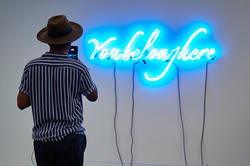As RISD’s 2016 Kirloskar Visiting Scholar, multidisciplinary artist Shahzia Sikander MFA 95 PT/PR is sharing insights about Islam, collaboration and multiculturalism through a series of public programs.
Sikander Show Opens at RISD Museum

By the time acclaimed artist, MacArthur award winner and RISD trustee Shahzia Sikander MFA 95 PT/PR arrived in the US to study at RISD in 1993, she had already spurred a revival of interest in traditional miniature painting in her home country of Pakistan. As a student and then faculty member at the National College of Arts in Lahore, she established the millennium-old art form’s relevance to contemporary subject matter before exploring new mediums at RISD—such as gouache and ink on tracing paper—and pushing deeper into issues of feminism, sexuality and colonial power structures.

A traveling exhibition of her work now on view at the RISD Museum traces the first 15 years (1987–2003) of Sikander’s creative journey from Lahore to Providence to Houston to New York City. On view through January 2022, Shahzia Sikander: Extraordinary Realities features 60 of her early works—drawings, paintings, animations and an installation—many of which have never before been exhibited.
“Polarizing dichotomies have long existed, and that’s what I was digging at: how to deconstruct exclusionary racial representations and tell richer stories,” Sikander explains in a video statement about the show. “Throughout the ’90s, while I was making these detailed paintings, I was also making installations that allowed me to tap into my concerns about empire, language, colonial histories, identity, sexuality and gender—interlocking themes that all of us experience.”
“Polarizing dichotomies have long existed, and that’s what I was digging at: how to deconstruct exclusionary racial representations and tell richer stories.”
The exhibition first opened at the Morgan Library & Museum, New York in June 2021. Once it closes at the RISD Museum, it will finish its tour at the Museum of Fine Arts, Houston from March 13–June 5, 2022.

Shahzia Sikander: Extraordinary Realities was curated by Houghton P. Metcalf Jr. Curator of Prints, Drawings and Photographs Jan Howard, who also coedited a companion publication of the same name (Hirmer, 2021). “It has been such a privilege to work with Shahzia,” says Howard, “and especially exciting to closely consider her early work through the critical perspectives of my exceptional coeditor for the book, Sadia Abbas, who was instrumental in its conception.” The book includes essays by artists and curators with deep connections to Sikander, such as former RISD Museum Director John W. Smith, longtime RISD Painting Professor Dennis Congdon 75 PT and fellow RISD alum Julie Mehretu 97 PT/PR.

Sikander and Mehretu were deeply engaged in an arts, culture and community revitalization project in Houston in the mid-1990s before both artists moved to NYC. Mehretu recalls that Sikander’s late-’90s exhibition openings at such venues as the Drawing Center and the Queens Museum of Art brought together disparate groups that were usually invisible in the art world: Pakistanis and Indians, East Africans and African Americans, trans and cis-gendered artists.


Twenty-five years later, Shahzia Sikander: Extraordinary Realities offers an inside view of Sikander’s developing style and global perspective on gender, sexuality, race, class and history. It begins with work Sikander made while studying miniature painting in Lahore, including her thesis piece, The Scroll (1989–90). Sikander says that “time is very much a part of The Scroll. It’s like a day in the life, or a glimpse of a lifetime.”

From there, the show moves on to reveal her development of a new personal vocabulary as a grad student at RISD and as a Core fellow at the Glassell School of Art at the Museum of Fine Arts, Houston, before segueing to work created during her first years in NYC. Layered pieces like Separate Working Things I (1993–95) continue to play with notions of time and history, while paintings like Eye-i-ing those Armorial Bearings (1989–97) and Uprooted Order, Series 3, No. 1 (1997) indicate movement and displacement, perhaps reflecting (as Abbas writes in the catalogue) “a world in which disorder is the norm, the normative is rejected, nothing seems what it is and the very suggestion of rootedness is farcical.”
“Multifaceted, nuanced and open-ended, these narratives shatter expected hierarchies, norms and stereotypes.”
Throughout her career, Sikander has been remarkably prescient, and the themes she has developed since the early 1990s continue to resonate in contemporary discourse. In Howard’s words, “Multifaceted, nuanced and open-ended, these narratives shatter expected hierarchies, norms and stereotypes… placing her among the most significant artists working today.”
—Simone Solondz
November 11, 2021


